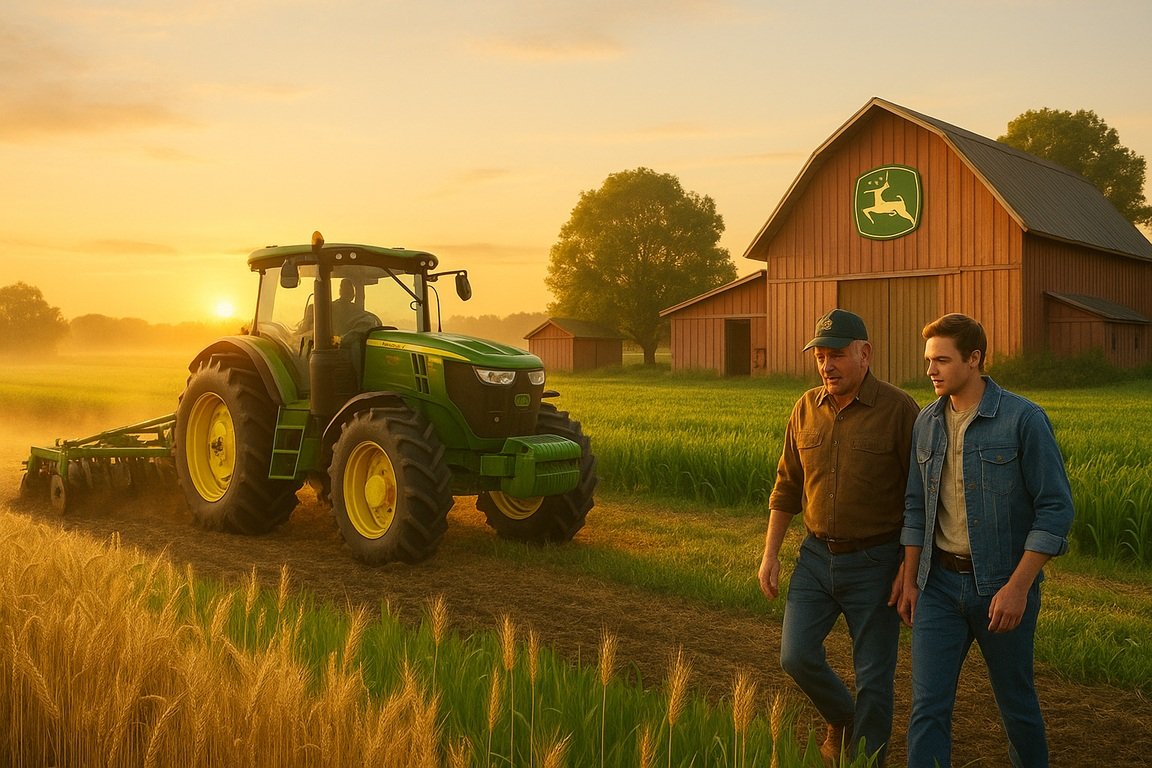Continue Reading With Our 7-Day Free Trial
John Deere is no longer just a symbol of tractors and green machines — it has quietly transformed into one of the most dominant forces in agricultural technology. At the intersection of artificial intelligence and farming, Deere is building a future where its equipment not only performs fieldwork but also interprets real-time data, automates decision-making, and boosts crop yields through precision. The company’s recent developments, including strong second-quarter financials for fiscal 2025 and an impressive Investor Day presentation in Brazil, reveal a clear trajectory: Deere is shifting from traditional machinery to becoming a full-scale agri-tech platform. This transformation is driven by a combination of advanced software, connected machinery, and geographic expansion. As it navigates macroeconomic headwinds such as tariffs and fluctuating commodity prices, Deere is also positioning itself for long-term dominance in precision agriculture. Here are four strategic drivers that explain how Deere has gained ground — and how it plans to retain its lead in this increasingly data-driven industry.
Precision Ag & Software-As-A-Service Model
Deere has made significant strides in converting its traditional farm machinery into intelligent systems powered by software and artificial intelligence. The company’s digital core is the John Deere Operations Center, a cloud-based platform that connects equipment, field data, and operational planning. More than 475 million acres globally are now “engaged” on the platform, with 30% categorized as “highly engaged,” meaning they actively leverage Deere’s digital tools for decision-making. Key technologies such as AutoTrac guidance, ExactEmerge planters, and See & Spray use AI and sensors to automate field operations. Notably, See & Spray technology allows for precision herbicide application, reducing chemical use by over 50%. Deere has also moved to a subscription-based model through offerings like Precision Essentials and G5 licenses, which allow farmers to access cutting-edge tools with lower upfront costs. In FY2025, Precision Essentials received nearly 10,000 orders globally — more than the total for FY2024 within just six months. This shift not only generates recurring revenue but also deepens customer reliance on Deere’s ecosystem. However, this model depends on long-term license renewals and broad adoption of connectivity tools such as JDLink Boost, especially in underserved regions with limited cellular coverage.
Brazil As A Global Growth Engine
Deere’s 25-year history in Brazil has positioned the company to benefit from one of the most agriculturally dynamic countries in the world. Brazil is the top global exporter of soybeans, sugar, and cotton, and the second-largest for corn. With over 275 dealerships, eight factories, and a newly established R&D center in Indaiatuba, Deere has built a local ecosystem tailored to Brazil’s vast and complex farming operations. The Cerrado region, with its double cropping and mega-farms (some over 25,000 acres), is ideal for Deere’s AI-enabled machinery. The company’s strategy in Brazil is to build localized equipment, develop precision solutions for tropical environments, and offer satellite-based connectivity via JDLink Boost — already installed on more than 4,000 machines. Order books are full through the third quarter of FY2025, and Deere plans to grow connected machines in Brazil by 2.5 times and expand digitally engaged acreage by 50% by 2030. The region’s push toward renewable energy, particularly ethanol derived from sugarcane and corn, further fuels demand for Deere’s equipment. That said, high interest rates and pressure on commodity prices remain potential constraints on capital expenditure by Brazilian farmers.
U.S. Manufacturing & Vertical Integration
Deere’s deep-rooted U.S. manufacturing base continues to be a competitive advantage. Approximately 80% of U.S. sales are fulfilled by domestically produced machinery, and over 75% of the components are sourced within the country. The company has committed over $20 billion to U.S. investments over the next decade, aimed at supporting advanced manufacturing, new product development, and integrating more software into its production lines. This strategy has enabled Deere to centralize its tech stack and apply it across multiple sectors. For example, the company is now integrating its Operations Center into roadbuilding equipment acquired through the Wirtgen acquisition, bringing autonomous and precision tools beyond agriculture. These efficiencies in design, production, and deployment reduce time to market and allow Deere to extend its reach into adjacent industries. However, this domestic manufacturing strength also comes with risks. Tariffs imposed on global trade components are expected to cost Deere over $500 million in fiscal 2025. While mitigation strategies — such as dual sourcing and USMCA certification — are in motion, any further trade tensions could pressure margins.
Navigating Cycles, Tariffs, & Inventory Challenges
Even with impressive long-term strategies, Deere faces a number of near-term challenges. High valuations of its equipment, elevated interest rates, and geopolitical uncertainties have softened demand, particularly in turf and small utility tractors. Deere reported a 16% drop in revenue for the second quarter of FY2025, although its 18.8% equipment margin exceeded expectations. The company has managed to reduce high-horsepower tractor inventory by 40% year-over-year and combine inventories by 25%, avoiding a glut that could force price cuts. Used equipment remains a sticking point — especially in the North American market — where a surplus of late-model machines continues to weigh on resale values. Deere and its dealer network are working through the issue via new financing options and incentive adjustments. The company’s early-order programs for FY2026 provide some flexibility in pricing, allowing Deere to respond to changing tariff policies. Still, margins are expected to decline in the second half of the year due to a combination of tariff costs, lower price realization, and less favorable production mix.
Key Takeaways
Deere’s dominance in agricultural equipment is no longer defined by horsepower alone, but by its integration of hardware, software, and data. The company has evolved into a precision agriculture platform, enabling farmers to do more with less through AI, connectivity, and automation. Its strong manufacturing base, rising footprint in Brazil, and pivot toward recurring revenue through SaaS models have collectively enhanced its strategic positioning. Yet, Deere’s high product valuations, exposure to global tariffs, and sensitivity to farm cycles pose tangible risks to future earnings growth. The company must continue managing these pressures while ensuring adoption of its digital technologies remains strong enough to justify the elevated expectations currently embedded in its stock price.





